2025 Placer.ai Office Index
See the evolution of office foot traffic patterns on a nationwide and regional level.
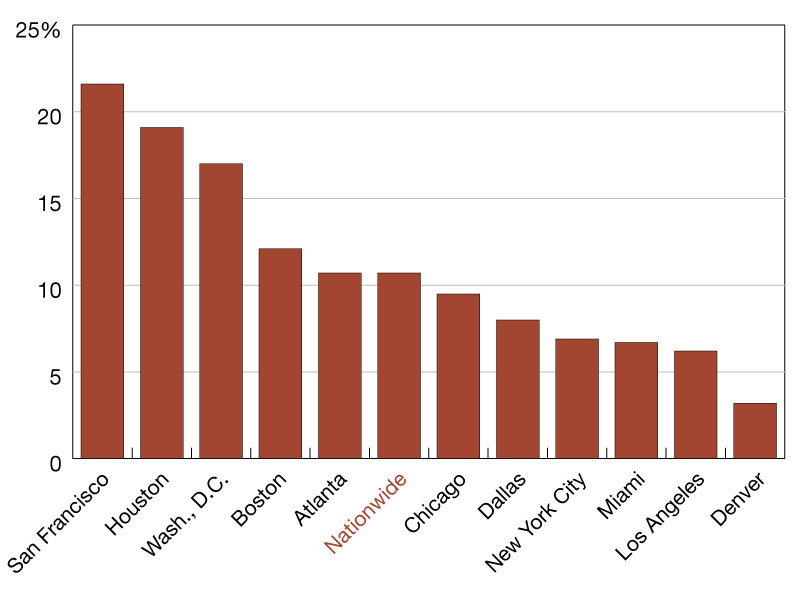
The office recovery is back in full swing. Major employers such as Samsung, Google and Starbucks have tightened return-to-office policies in recent months. And though hybrid work remains prevalent across industries, the second quarter of 2025 saw a majority of Fortune 100 employees subject to full-time in-office mandates—up from just 5.0 percent in the second quarter of 2023.
In June, accumulating RTO mandates helped shrink the post-pandemic office visit gap to 27.4 percent, compared to the same period in 2019. And July 2025 set a new record for office attendance, with visits down just 21.8 percent relative to July 2019 (both Julys had 22 working days)—making it the single busiest in-office month since COVID-19.
Office visit gaps close in NYC and Miami
Stark regional differences remain, however, between major business hubs nationwide. New York City, where many employees are subject to the stricter in-office requirements of the finance world, saw positive (+1.3 percent) year-over-six-year office foot traffic growth in July 2025—a first since Placer.ai began tracking these trends. Miami, which has developed a thriving financial sector of its own, followed closely behind, effectively closing its visit gap with a 0.1 percent lag.
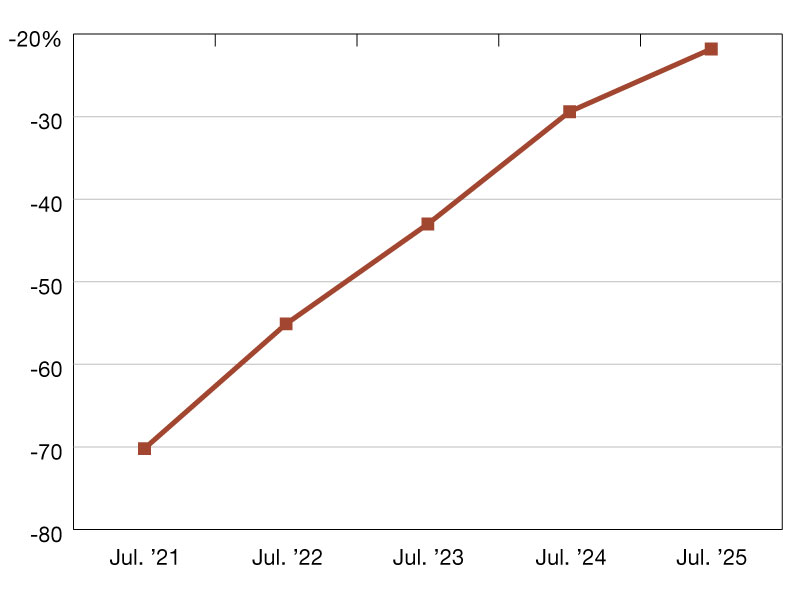
Atlanta and Dallas also made considerable headway—both markets saw visit gaps dip below 20 percent compared to 2019. Meanwhile, Denver—an emerging hub for tech startups and one of the most remote-friendly labor markets in the U.S.—took up the rear, while San Francisco inched up two notches in the rankings, beating out both Denver and Los Angeles.
Indeed, San Francisco appears to be in the midst of a major revival, with rising rents, improving public sentiment, and waves of new restaurant, retail and small business openings breathing fresh life into a city once dismissed as stuck in a “doom loop”. And in July 2025, the City by the Bay once again topped the year-over-year office recovery charts, outpacing all other analyzed hubs with remarkable 21.6 percent visit growth—more tangible evidence of the progress San Francisco continues to make.
—Posted on August 29, 2025
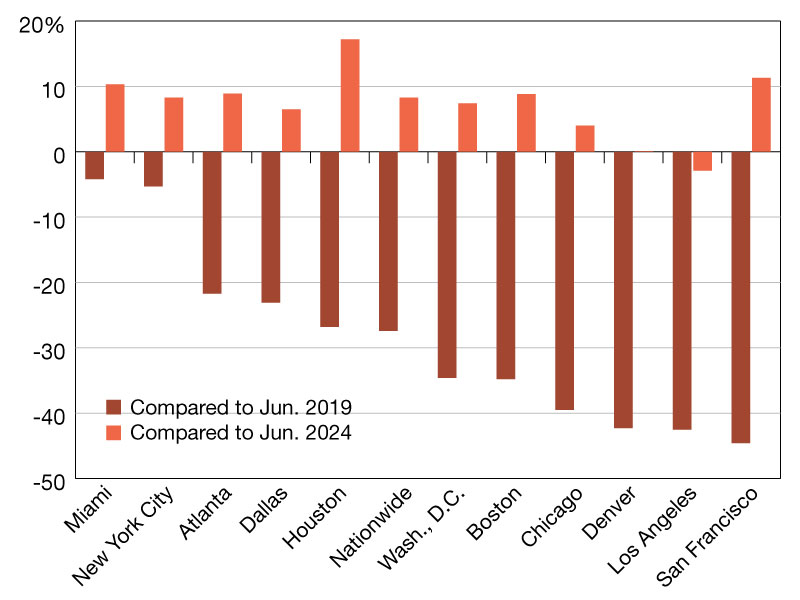
2025 is shaping up to be the year of the RTO mandate. Local governments and companies across industries—from AT&T to Amazon and Starbucks—have introduced stricter in-person requirements, with some even shifting back to a full five-day, in-office work week. Still, rolling out these mandates hasn’t been entirely smooth sailing, and many workplaces still strive to strike a balance between RTO and WFH.
So how are these trends unfolding on the ground? Did the office recovery continue to stagnate as it did in May, or did the start of the summer reignite RTO momentum? We dove into the data to find out.
Mandate-driven momentum
After losing a bit of steam in May, office visits regained their stride in June. Foot traffic to the Placer.ai Nationwide Office Index was just 27.4 percent below pre-COVID-19 levels—a significant improvement from June 2024, when it was down by 32.9 percent. While part of this uptick can be attributed to June 2024 having one fewer working day (19, compared to 20 in both 2019 and 2025), the data nevertheless points to meaningful RTO progress.
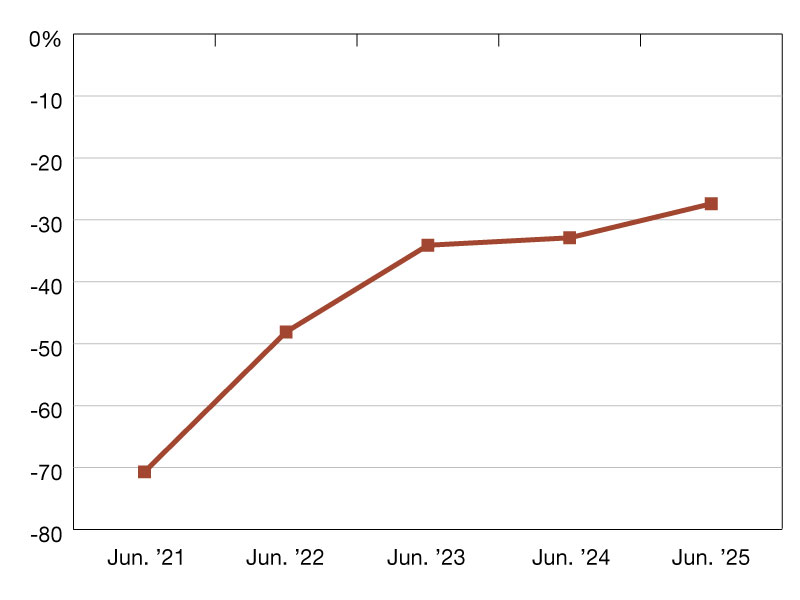
And looking at monthly fluctuations in office visits since June 2019 further highlights the month’s strong performance. Despite having only 20 working days, June 2025 ranked as the fourth busiest in-office month since the pandemic, trailing only October 2024, July 2024 and April 2025—each with 22 working days.
Miami and New York set the pace
Once again, Miami and New York led the RTO charge, with both cities nearing a full post-pandemic recovery. Miami posted just a 4.2 percent gap compared to June 2019, while New York recorded a 5.3 percent deficit—putting them both well ahead of the nationwide average. Sunbelt cities such as Atlanta, Dallas and Houston also outperformed the U.S. overall, reflecting a robust return to workplaces in these regions.
Most of the cities analyzed also saw notable year-over-year gains in June 2025—partly attributable to this June’s extra work day. Los Angeles was the only hub to experience a year-over-year gap—potentially linked to last month’s local protests, which may have disrupted commuting routines for some employees. Houston, for its part, lapping a storm-ridden June 2024, recorded an impressive 17.2 percent year-over-year bump. And though San Francisco remained farthest from its pre-pandemic attendance levels, the city maintained its strong year-over-year streak, suggesting steady recovery in its tech-heavy landscape.
—Posted on July 30, 2025
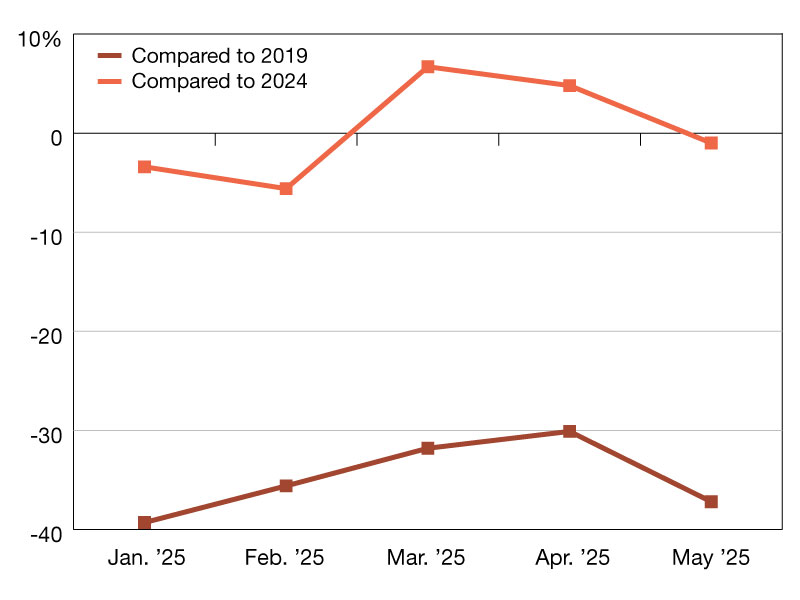
Following a strong April when nationwide office visits rose 4.8 percent year-over-year, visits fell slightly in May 2025 as traffic fell 1 percent compared to May 2024. On a year-over-six-year basis (or compared to 2019), visits were down 37.2 percent—a steep drop from April’s 30.1 percent year-over-six-year visit gap.
The weaker May numbers may be partially driven by a calendar shift, as May 2025 had an extra Saturday, and therefore one less workday, than either May 2024 or May 2019. Americans may have also chosen to take more PTO around Memorial Day this year—according to the TSA, airports were busier on the Friday before Memorial Day 2025 than they were on Friday, May 24th 2024.
But the muted May office data also highlights the persistent popularity of hybrid and remote work. According to Gallup, over half of U.S. employees work hybrid while over a quarter are fully remote—and the recent May data suggests that these work arrangements are proving difficult to change.
New York, Miami and Southern hubs lead May 2025 office recovery
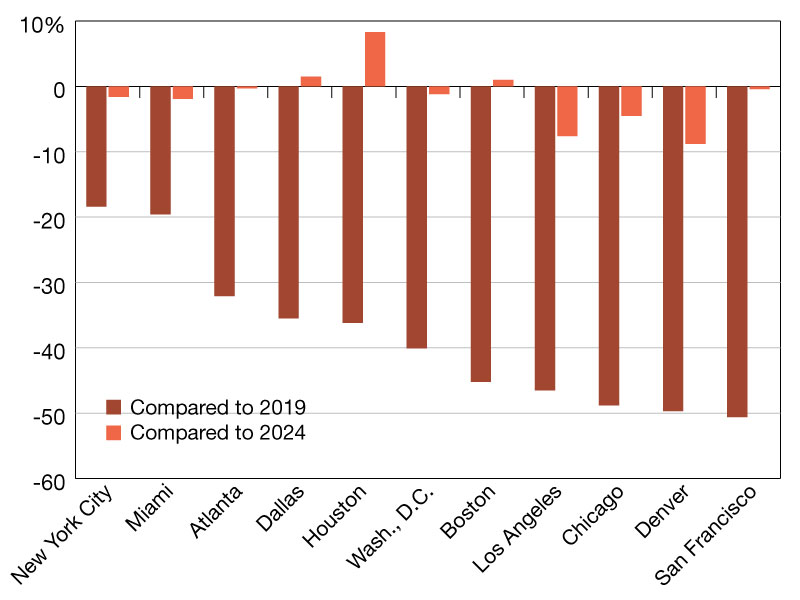
Diving into the market-level data reveals that New York City and Miami continue to lead the pack, with office visits down 18.4 percent and 19.6 percent, respectively, compared to 2019. But both cities also saw slight declines compared to May 2024’s office numbers—highlighting once again the persistence of the new work arrangements and the overall slowing of the office recovery.
Southern hubs—specifically Atlanta, Dallas and Houston followed New York and Miami, with visits down 32.1 percent, 35.5 percent, and 36.2 percent compared to May 2019. Dallas and Houston also saw their office visits increase compared to 2024, with Houston specifically seeing an 8.3 percent increase in year-over-year office visits, perhaps aided by corporate relocations to the two cities. Georgia and Texas also saw their populations increase in recent years, which may be contributing to these cities’ office performance.
Meanwhile, the year-over-six-year office visit gap in Washington, D.C., Boston, Los Angeles, Chicago, Denver and San Francisco ranged from 40.1 percent to 50.6 percent, with all the cities except for Boston also experiencing year-over-year declines.
—Posted on June 26, 2025
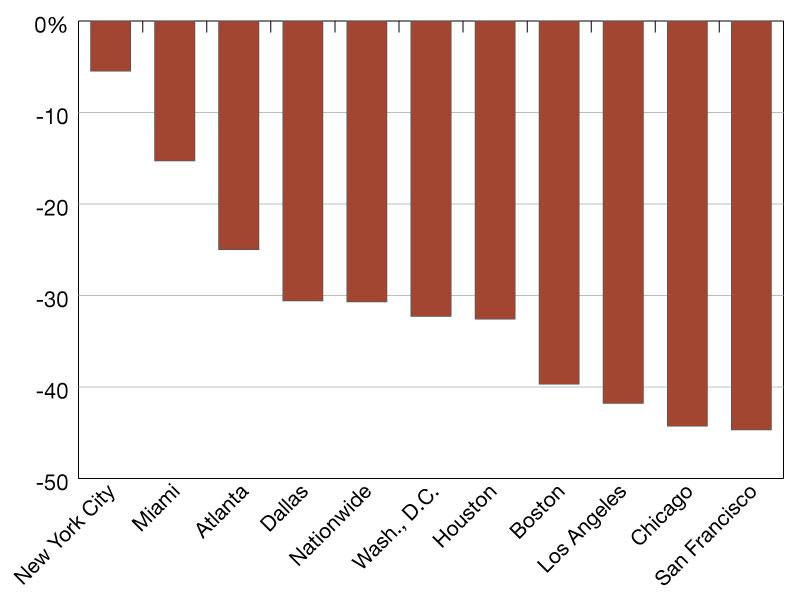
With Google and Uber joining the ever-growing ranks of companies tightening remote work policies, employees across industries are being forced to spend more time in the office. But how much are office visit patterns really changing on the ground? Did the resurgence observed in March 2025 continue into April, or was it merely a brief reprieve from the slump seen earlier this year?
Third-busiest in-office month since COVID-19
April 2025 emerged as the third-busiest in-office month since the pandemic, outpaced only by October and July 2024. Visits to the Placer.ai Nationwide Office Index were down just 30.7 percent compared to April 2019 (pre-COVID-19)—an improvement over April 2024. The upswing is especially notable given that Easter fell in April this year, whereas last year it fell in March. Though the holiday itself takes place on Sunday, many employees celebrate the occasion with a long weekend.
April 2025’s strong performance suggests that despite setbacks in January and February, the office recovery is back on track, with further increases potentially ahead in the coming months.
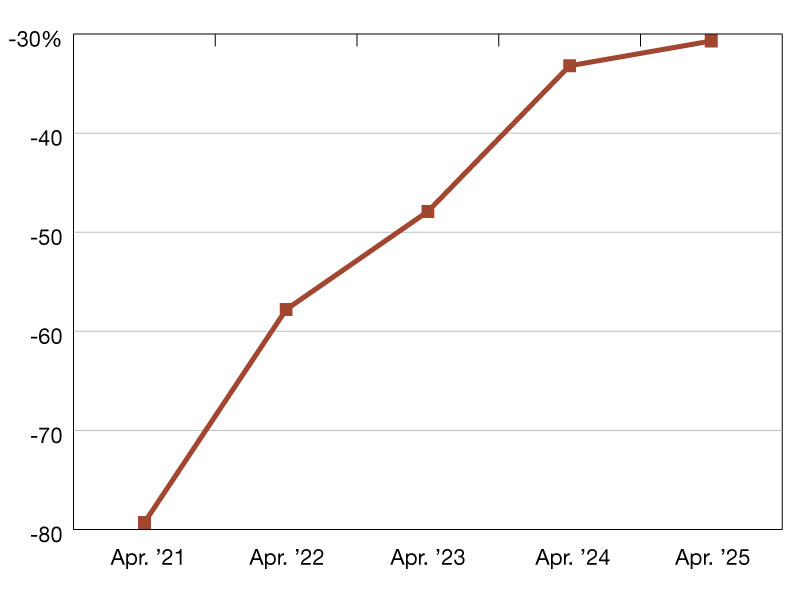
New York’s near-complete recovery
A closer look at regional trends shows significant variation across major business hubs. New York City, long at the forefront of office recovery, nearly closed its post-pandemic office visit gap in April 2025, with visits just 5.5 percent below April 2019 levels. Miami also performed strongly, with visits down only 15.3 percent. Meanwhile, Atlanta and Dallas outperformed the national baseline (Dallas, just barely), while San Francisco once again took up the rear with Chicago.
Tuesdays and Wednesdays are back! (in NYC)
Drilling down deeper into the data for office recovery leaders, New York and Miami highlights the continued influence of hybrid work on office visitation trends, even as numbers approach pre-pandemic levels.
Nationwide, office visits recovered most strongly mid-week. But this trend was especially pronounced in nearly-recovered NYC, where Tuesdays and Wednesdays were actually busier last month than they were during the same period of 2019 – and where Thursdays were essentially on par with April 2019 levels. Meanwhile, Fridays, and to a lesser extent Mondays, remained significantly below pre-COVID benchmarks. In Miami, too, it was midweek attendance that powered the office recovery – though Fridays rebounded more strongly in the Florida hub than in New York or nationwide.
San Francisco leads in YoY growth
Turning to year-over-year trends, San Francisco once again led in annual office visit growth—suggesting that accumulating RTO mandates in the city’s tech sector may be fueling substantial recovery. Boston was not far behind, with visits up 7.4 percent year-over-year. And while most other cities also posted year-over-year visit growth, a few hubs, including Houston and Los Angeles, saw modest declines.
This blog includes data from Placer.ai Data Version 2.1, which introduces a new dynamic model that stabilizes daily fluctuations in the panel, improving accuracy and alignment with external ground truth sources.
—Posted on May 29, 2025
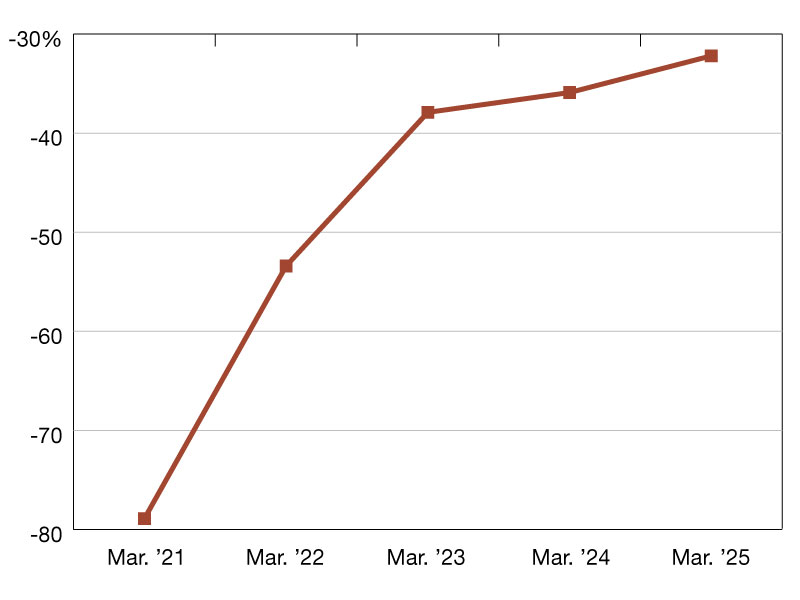
Return-to-office mandates seem to be everywhere. Following the federal government’s example, local governments from the City of Atlanta to the State of Texas have introduced stricter in-office requirements. And an increasing number of corporations are demanding full-time in-person work—including firms like JPMorgan, which began enforcing a five-day RTO mandate in early March.
But what does ground-level data tell us about how these new policies are affecting office attendance in practice? Did the RTO slowdown observed in January and February continue into March? Or is a new resurgence underway?
RTO marches ahead
The latest data from the Placer.ai Office Index suggests that nationwide office visits may be trending upwards once again. Although March 2025 office visit levels didn’t match the peaks of October and July 2024, visits last month were only 32.2 percent below March 2019 levels—an improvement over March 2024.
Significantly, among months with 21 or fewer working days, March 2025 ranked as the second-busiest in-office month since the pandemic, just slightly behind October 2023 (October and July 2024 both had 22 days). So while January and February’s declining numbers hinted at a stalled market, March’s uptick suggests that lower office attendance earlier in the year may have been due to temporary factors like weather, and that the RTO may still be gaining momentum.
New York Still in the lead
Diving into the data for eleven major business hubs nationwide shows New York City and Miami once again at the head of the office recovery pack. Visits to NYC office buildings in March 2025 were just 11.4 percent below pre-pandemic (March 2019) levels, while Miami trailed by 17.3 percent.
Meanwhile, Atlanta (-29.3 percent), Washington, D.C. (-30.6 percent), Dallas (-30.7 percent) and Houston (-31.0 percent) all outperformed the nationwide average of -32.2 percent. San Francisco tied in last place with Chicago, with visits 44.6 percent below 2019 levels.
YoY upticks (nearly) across the board
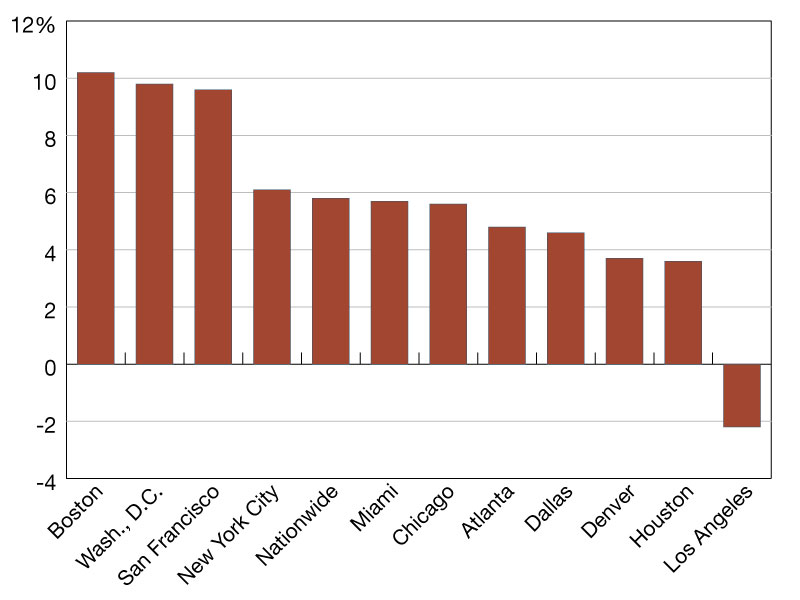
Turning to year-over-year data, ten of the eleven analyzed cities experienced year-over-year office visit growth—led by Boston, with a 10.2 percent uptick. Washington, D.C. also recorded strong annual gains (9.8 percent), while San Francisco continued its recent positive momentum with a 9.6 percent increase. Los Angeles was the only city to see a minor (-2.2 percent) year-over-year visit lag—perhaps lingering fallout from the wildfires earlier this year.
Overall, the Placer.ai Office Index points to a renewed upswing in RTO momentum, likely driven by increasingly strict mandates from governments and corporations. Though persistent post-pandemic office visit gaps point to the continued prevalence of hybrid work, March’s noticeable uptick suggests that offices may be poised to make further gains in the coming months.
—Posted on April 29, 2025
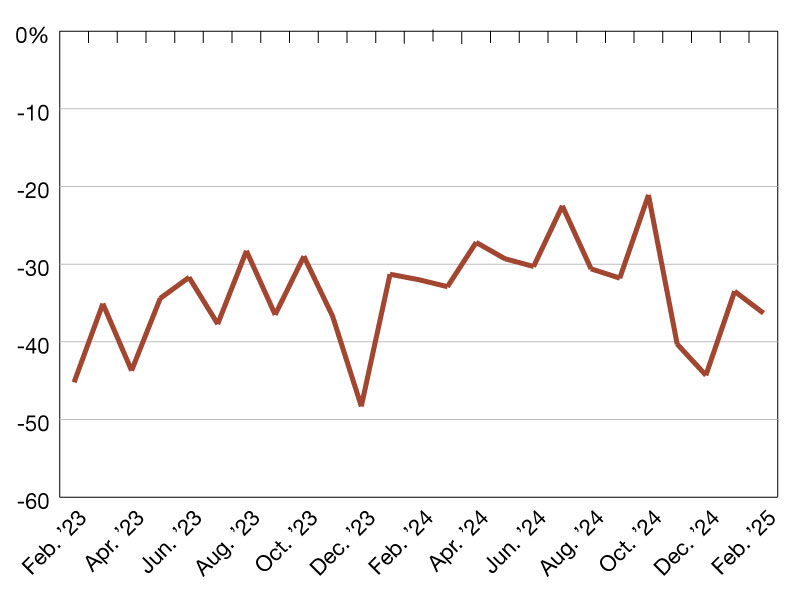
While headlines trumpeting an imminent return to traditional office life fueled by corporate mandates have become increasingly common in recent months, ground-level data reveals a more complex reality. Office building foot traffic indicates that the office recovery has slowed, with February visits down by 36.3 percent compared to pre-pandemic levels in February 2019. This data suggests that despite top-down pressure and return-to-office mandates at several major U.S. companies, hybrid and remote work models remain widespread.
New York and Miami lead the RTO recovery
Diving into the market-level data reveals that the nationwide average office occupancy metric was driven by relatively significant visit gaps across most analyzed cities, with the exception of New York City and Miami that continued to lead the return to office trends, followed by Atlanta. Houston, Washington D.C., and Dallas all experienced year-over-five-year visit gaps of 34.6 percent to 38.4 percent—close to the nationwide average—while the year-over-five-year office visit gaps for Boston, Los Angeles and Denver was 43.5 percent, 45.1 percent and 46.6 percent, respectively.
But one metric did stand out in the February data that could hint at a relatively localized return-to-office acceleration. For the first time since we started tracking the post-pandemic office recovery, San Francisco (47.5 percent year-over-five-year visit gap) outperformed Chicago (48.5 percent)—perhaps indicating that RTO mandates in the tech world are beginning to move the needle in the country’s tech capital.
Year-over-year data points to a stalling recovery
The slowing RTO trends also emerge when analyzing the year-over-year data. Although some visit gaps were to be expected given the comparison to a 29 day February in 2024, most cities—with the exception of Miami, Boston and San Francisco—saw a larger dip in office visits than the approximately 3.5 percent visit gap that could be attributed to the calendar shift.
The dip in office visits compared to 2024 suggests that the RTO mandates are not having a significant impact on office occupancy patterns in most major cities and further underscore the enduring impact of remote and hybrid work models.
—Posted on March 28, 2025
Nationwide, January 2025 office visits were 40.2 percent lower when compared to pre-pandemic January 2019. A confluence of factors, including last month’s polar vortex, as well as the mid-week New Year’s Day, likely resulted in fewer office visits than usual.
New York continued to lead the return-to-office pack, with office visits in the Big Apple just 19.0 percent lower than in January 2019. Analyzing the year-over-year data indicates that the polar vortex likely had a greater impact on employees in typically warmer climates while employees in cities that tend to have colder winters seemed less affected.
Temporary setback for RTO
Several factors seem to have converged in January 2025 to temporarily hamper the return-to-office recovery. First, last month brought a polar vortex to much of the United States, compelling Americans to stay indoors and avoid unnecessary trips outside—including to the office. January 1st also fell on a Wednesday this year, and many people likely took advantage of the calendar luck to extend their vacation through the weekend—leading to fewer January office visits compared to years when New Year’s Day falls earlier in the week.
As a result, the January 2025 bump appeared relatively muted: visits in January 2025 were only 17.7 percent higher than in December 2024, compared to a 31.3 percent month-over-month increase from December 2023 to January 2024. And visits were 40.2 percent lower than they were in pre-pandemic January 2019—a slightly worse showing than the 39.2 percent pre-pandemic visit gap of December 2024.
New York continues to lead the RTO pack
The meteorological and calendar challenges seem to have impacted office visits on a metro area as well, with few cities analyzed making significant RTO strides in January 2025. The sole exception was New York, where January 2025 visits were only 19.0 percent lower than they were in January 2019—a slightly smaller visit gap than the previous month.
Many of the cities where residents are used to and equipped for the colder weather—Chicago, Boston, and New York—seemed to have experienced a relatively minimal impact from the arctic blast. The one exception was Denver, which was exceptionally frigid—with subzero temperatures—so that even those used to cold may have opted to work from home.
But in metro areas where weather tends to be relatively warm—including Atlanta, Houston, Washington, D.C., and Dallas—the impact of the polar vortex was visibly stronger. In these cities, the year-over-year visit gap ranged from 7.5 percent (Atlanta) to 12.0 percent (Dallas)—as employees without proper winter jackets or snow tires likely chose to stay cozy and avoid the chill.
January 2025’s RTO stats may not have been particularly impressive, but the relatively weak office data is likely more a reflection of last month’s unique challenges rather than a slowdown in the RTO momentum. With the weather now back to normal and no mid-week holidays in the near future, the coming months will be critical in evaluating if the RTO is in fact slowing down or whether January just marked a temporary setback within a still unfolding story.
For more data-driven insights, visit placer.ai.
This blog includes data from Placer.ai Data Version 2.1, which introduces a new dynamic model that stabilizes daily fluctuations in the panel, improving accuracy and alignment with external ground truth sources.
—Posted on February 26, 2025

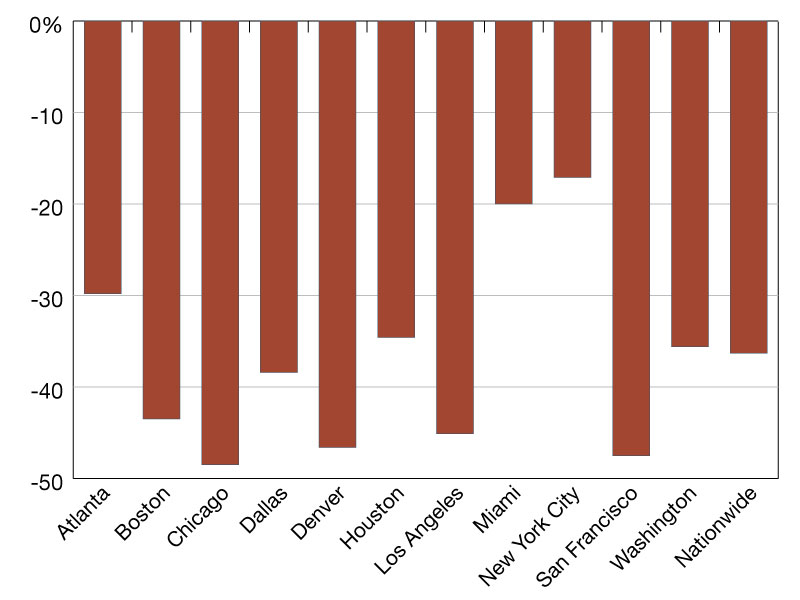


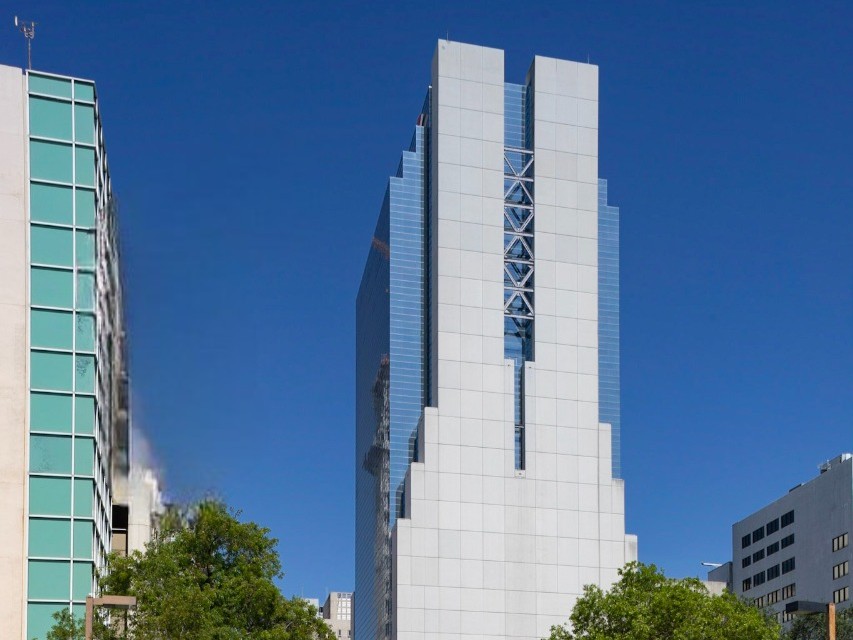
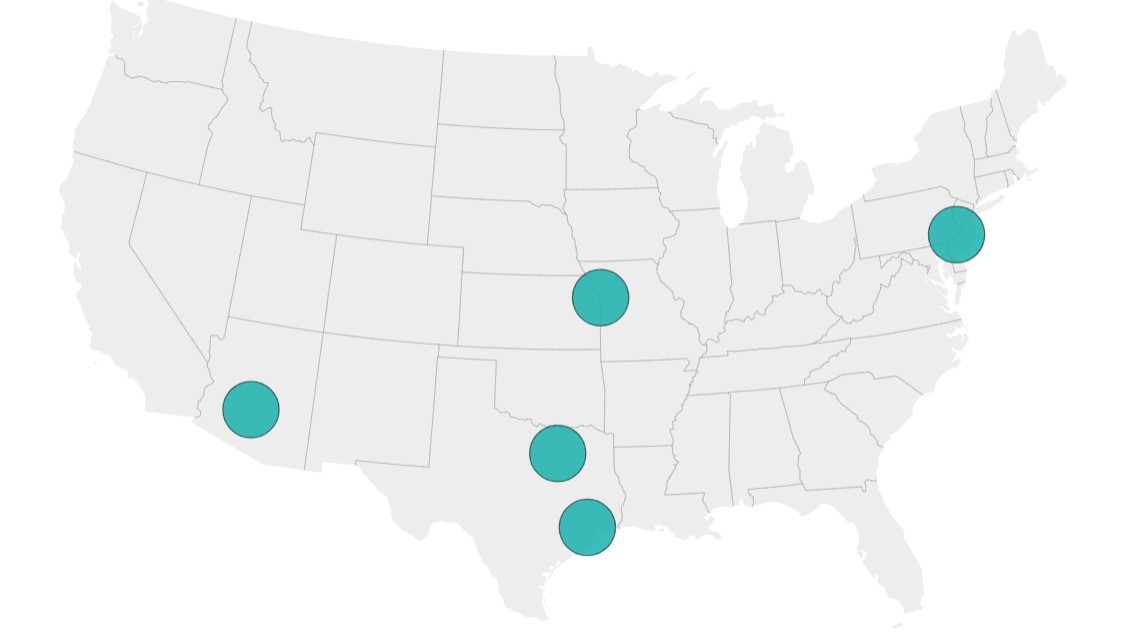
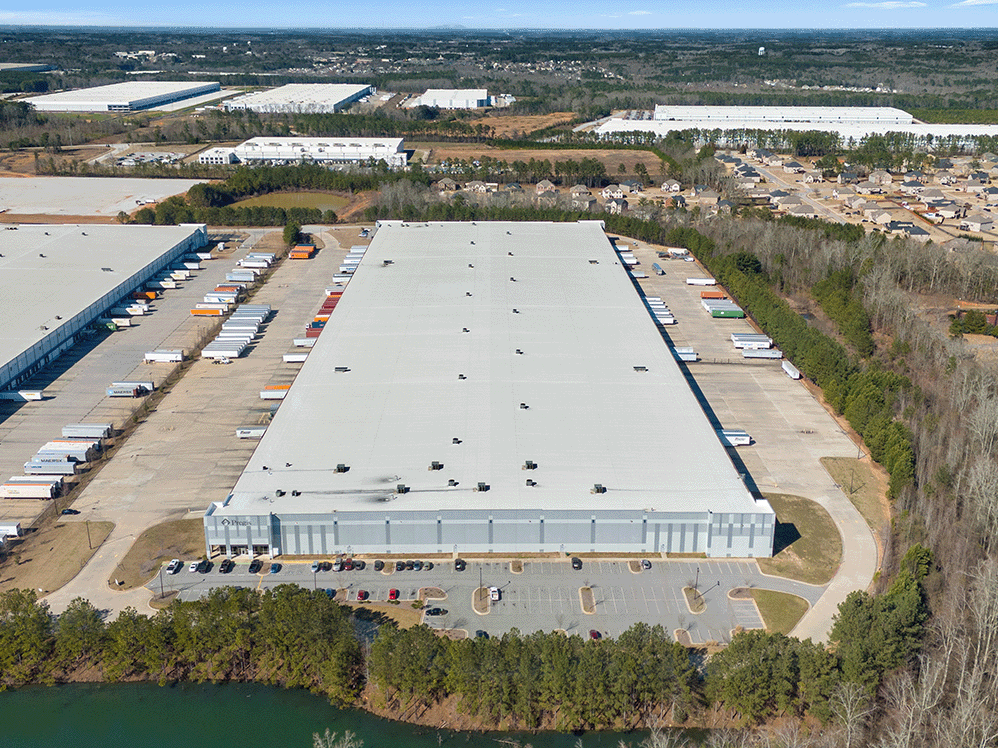
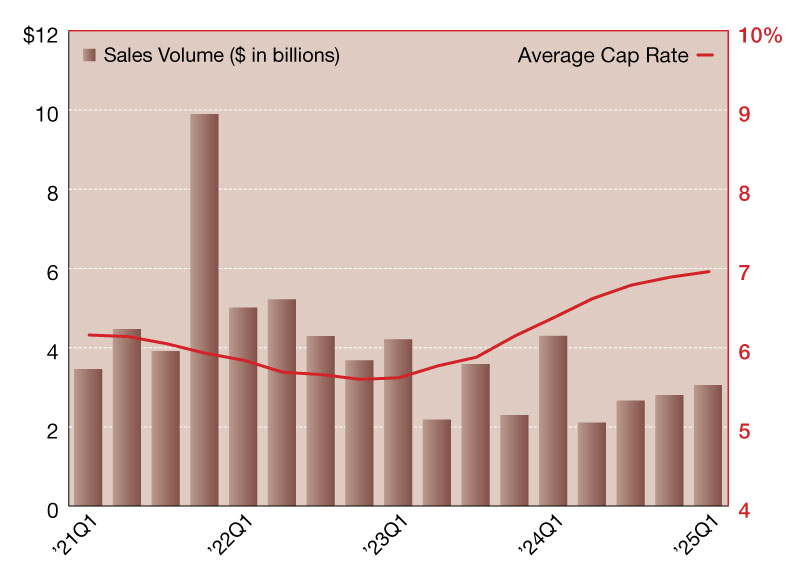
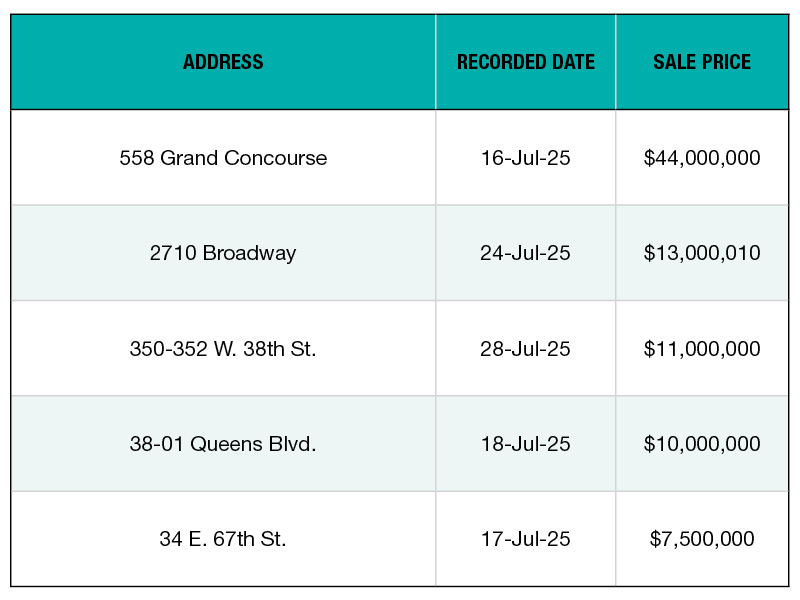
You must be logged in to post a comment.